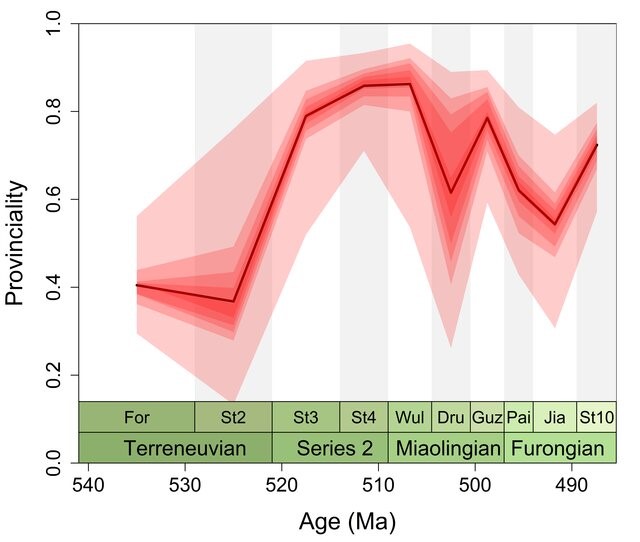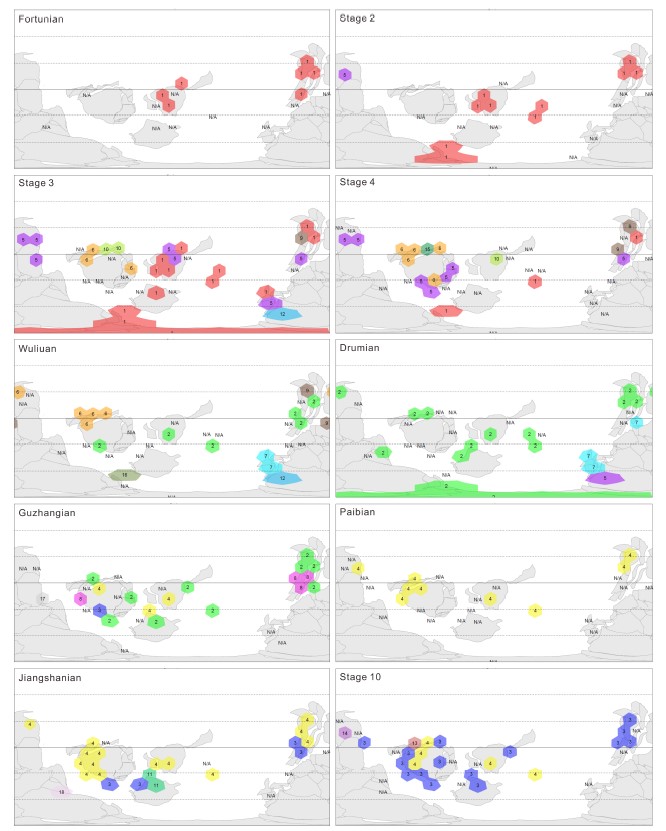The Cambrian witnessed a noteworthy radiation in biodiversity and a remarkable divergence in Bau plans of marine metazoans. Although the temporal and spatial patterns of Cambrian biodiversity have been widely documented, less attention has been paid to the fundamental biogeographic structure and its changes through time. And it remains unclear how these changes scale up to first-order biogeographic patterns, which may provide insights into evolutionary processes during large-scale diversifications at different temporal scales.
Recently, Dr. NA Lin and Dr. LI Qi-jian from Nanjing Institute of Geology and Palaeontology, Chinese Academy of Sciences (NIGPAS) and his collaborators from University of Erlangen-Nuremberg outline time-traceable provinces for marine invertebrates across the Cambrian period using a compositional network based on species-level fossil occurrence data. The results have been published online in the Paleobiology, the official publication of the Paleontological Society.
The study confirms an increase in regional differences (Fig. 1) of faunal composition and a decrease in by-species geographic distribution during the first three stages. The results also show that general biogeography tends to be reshaped after global extinction pulses (Fig. 2). The authors suggest that the abrupt biogeographic differentiation during the Cambrian radiation was controlled by a combination of tectonics, paleoclimate, and dispersal capacity changes. So this study provides further evidence for the evolution of biogeographic patterns during and after the Cambrian radiation.
This study was jointly supported by the Youth Innovation Promotion Association of CAS, grants from the Strategic Priority Research Program (B) of CAS and the State Key Laboratory of Palaeobiology and Stratigraphy (NIGAPS).
Reference: Na, L., Kocsis, á, Li, Q.*, & Kiessling, W. (2022). Coupling of geographic range and provincialism in Cambrian marine invertebrates. Paleobiology, 1-12. https://doi.org/10.1017/pab.2022.36.

Figure 1 Trajectory of provinciality from the Fortunian to Stage 10 of the Cambrian, based on Hurlbert's probability of interspecific encounter (PIE).

Figure 2 Paleogeographic positions of sampled bioregions for the ten 10 Cambrian stages. Numbers and colors indicate time-traceable bioregions.
Contact:
LIU Yun, Propagandist
Email: yunliu@nigpas.ac.cn
Nanjing Institute of Geology and Palaeontology, Chinese Academy of Sciences
Nanjing, Jiangsu 210008, China
Download:
